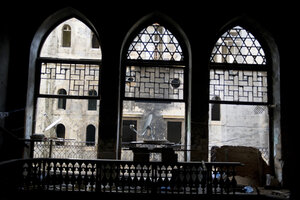Where are the world's most endangered monuments?
The World Monuments Fund releases its 2016 'Watch List' to raise awareness of preservation needs around the globe.

The interior of the Heneine Palace, once home to 'Dr. Dahesh,' a Lebanese mystic, artist, and philosopher, now houses squatters in one of Beirut’s conservation areas, Nov. 16, 2012, in Beirut, Lebanon.
Ann Hermes/The Christian Science Monitor/File
Today the World Monuments Fund announced its 2016 list of culturally significant sites at risk from environmental degradation, urbanization, and social or political turmoil.
The Watch List, as it is known, is an advocacy tool used to raise "worldwide concern" about the WMF’s preservation efforts around the globe.
"The 2016 Watch includes many extraordinary places that deserve to be celebrated because they represent high moments of human culture," said Bonnie Burnham, WMF president and CEO. "WMF looks forward to working with the local experts, organizations, and government agencies who have nominated these sites. We hope our endorsement will advance their goals to save each of these cherished places."
The 2014 Watch List included 67 sites in 41 countries and territories, including the Gateway Arch in St. Louis, under threat from corrosion, and the city of Venice, which has been dealing with high waters and flooding for generations.
For the updated list, some new monuments were added and others removed, resulting in a list of 50 sites in 36 countries, including: all of Nepal's cultural heritage sites, destroyed by a devastating earthquake; an ancient, underwater city, threatened by pollution and cruise ships (Pavlopetri, Greece); a medieval Swahili town at risk from looters and a harsh climate (Kua Ruins, Tanzania); a "modern engineering masterpiece on the verge of being dismantled" (Shukhov Tower, Russia); and dozens more.
The WMF also added the "Unnamed Monument ... in recognition of the deliberate and calculated damage to thousands of cultural heritage sites in many areas of political and social instability."
Throughout war zones in the Middle East, the WMF has worked with conservation professionals to identify historically and culturally significant sites for preservation.
In Syria, the WMF partnered with a local conservation agency to unearth seven different conservation projects at the Citadel of Aleppo, a city whose history dates back to the Bronze Age. The Citadel and other sites like it have been threatened or destroyed by Syria's civil war, which erupted in 2011.
The new list also includes known and as-yet undiscovered World War II concentration camps in Italy "to bring attention to this vanishing piece of history and the need for further research to uncover the remaining sites."
It also recognizes the Buddhist and Hindu heritage sites that were destroyed in the aftermath of the 2015 earthquake in Nepal, "[to honor] the resilience of the Nepalese people, while bringing attention to the need for sustained international [preservation] efforts."
Inclusion on their Watch List does not guarantee funding or an influx of better preservation methods, cautions the WMF, but the recognition can help fundraising efforts. Since the Watch List’s founding in 1996, sites have raised approximately $240 million for conservation, and the WMF has donated an additional $100 million to select sites.
American Express, the founding sponsor of the World Monuments Watch, has given $16.5 million to 160 projects in 70 countries, says WMF.
"The World Monuments Watch is the most important call-to-action for the preservation of at-risk historical sites across the world," said Timothy J. McClimon, president of the American Express Foundation. "For two decades, the Watch has been a driving force in securing funding and engaging local communities to preserve these endangered cultural treasures."

